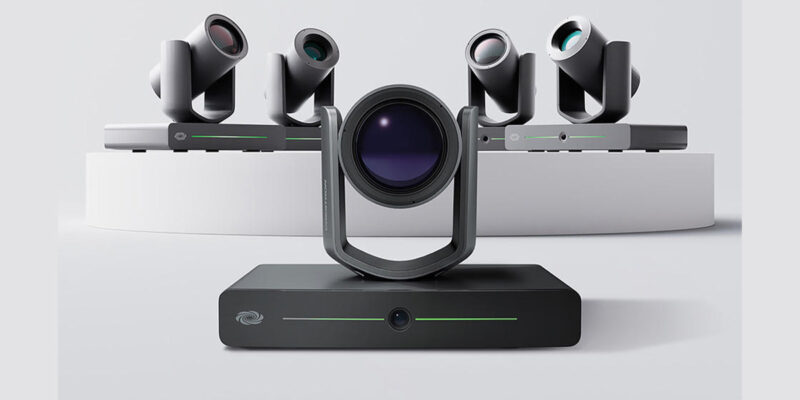5 Things to Know About UCC Ahead of InfoComm 2021

With the COVID-19 pandemic continuing for much longer than anyone expected, it should come as no surprise that conferencing and collaboration is a major focus for AV professionals. According to one report, the unified communication and collaboration (UCC) market size is expected to grow from USD 67.4 billion in 2021 to USD 127.5 billion by 2026.
There’s no doubt there will be a heavy emphasis on UCC products and services at InfoComm 2021. In fact, the show will feature a Conferencing & Collaboration Pavilion with exhibitors like Google and Lenovo taking large booths. The show will also feature education sessions focused on UCC with topics ranging from space design to software-based systems and more.
Ahead of the show, we spoke with InfoComm 2021 exhibitors to explore what conferencing and collaboration trends AV professionals should be aware of before they head to Orlando for the show.
1. Collaboration Displays are Central to the Conferencing Experience
“With video calls and hybrid meetings being the standard for nearly every company in the world, we are also seeing record growth for interactivity features on collaboration displays. With an entirely digital system, each participant can see, hear and contribute as if they were in the meeting — we call this ‘meeting equity.’ According to Gartner, 94% of organizations are now more flexible as to where and when employees work. That workplace phase shift has led to a rapid escalation in dispersed teammates, but unequal participation capabilities hinder the productivity of hybrid meetings. By introducing features that enhance and equalize interactivity, such as digital whiteboarding, and stellar improved audio and video tools, interactive collaboration displays are the pinnacle for enabling equitable meeting experiences.“
—Dana Corey, SVP & GM, Avocor
2. Intelligent Cameras are Critical for Conferencing Equity
“The biggest trend in UCC is the move to more video in our communications and the ease of turning an audio call into a video meeting, including meeting recordings in group chat, recording video meetings with transcripts that can be searched, etc. Having cameras in rooms of all shapes and sizes is now critical. It’s not enough to have small huddle spaces or laptops with webcams. We need cameras in multi-purpose rooms, training rooms, and large boardrooms. And automated camera tracking with intelligence becomes essential to give equity to remote participants and in-room participants in hybrid meetings and classes.”
—Rony Seebok, VP Technology, 1 Beyond
3. The User Experience Matters
“Prior to the pandemic, the trend was to reduce the complexity of our workspaces which were packed with devices to support fixed purposes such as presentation, video conferencing, collaboration, etc. The equipment and infrastructure costs were growing at an alarming rate. Not only did we need to budget for fixed hardware costs, but the labor and maintenance to support all these separate systems was really taking a toil on the AV and IT teams. COVID has really accelerated the future of the workplace putting additional pressure on an already overloaded model. In particular, a hybrid workforce model has to provide an inclusive experience for blended employee collaboration to be successful. This situation challenges our industry to innovate functional consolidation of key functions such as video conferencing and wireless presentation to ensure employees, whether onsite or remote, can seamlessly work together.”
—Christina Armstrong, Director of Global Communications and Marketing, ScreenBeam
4. Cloud-Based Adoption is Set to Increase
“One noteworthy UCC trend is the adoption of cloud-based platforms. This not only brings flexibility and scalability to IT managers responsible for troubleshooting large numbers of equipped spaces, but AV/IT companies can capitalize because of great manufacturer partners. Conference rooms and meeting spaces have often received inadequate management due to the challenge for IT managers of physically addressing multi-rack units in each room. Now that they can instead remotely troubleshoot and manage spaces through platforms like Crestron’s XiO Cloud; not only are experiences streamlined for those using collaboration spaces, but IT teams have their time freed to focus on longer-term objectives.”
—Alex Peras, Director of Product Management, UC and Corporate Partnerships, Crestron
5. Hybrid is the New Normal
“I have been in the video conferencing space for almost 20 years now and I can honestly say the dream has finally become a reality. When I first started companies where debating over using ISDN line or Static IP addresses. Now my kids are logging on to video calls every morning to meet with their teachers and classmates. The UCC space has finally been fully adopted and is now a necessity for all companies not just the Fortune 500’s. In a post-COVID world as people start to go back in the office, they will continue to utilize video conferencing. They have learned that being able to meet with clients and outside organizations via video is a far better form of communication rather than just a call over the phone. Full collaboration with integrated presentations gives users the feel of being in the room with their counterparts. This is the new norm. We will continue to see the UCC space grow and innovate to make communications simpler and even a more integral part of our business life.”
—Charles Montoya, Director of Sales and Marketing of UC Products, MAXHUB
To see the latest conferencing and collaboration solutions for pro AV, visit these manufacturers and more InfoComm 2021.
To stay up-to-date with the latest show news, visit our InfoComm 2021 microsite.





